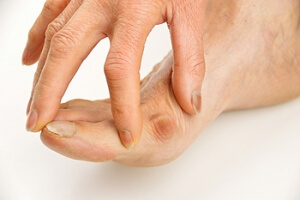What to Do About Blisters Between the Toes
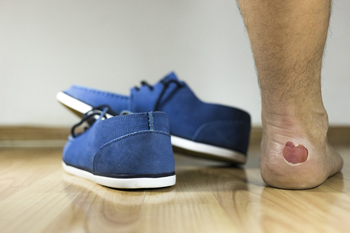
A blister is a fluid-filled bubble that forms on the skin. Most often these blisters are caused by one toe repeatedly rubbing against another toe or the lining of a shoe and irritating the skin. These are referred to as friction or pinch blisters and can typically be treated at home. Wearing shoes that fit properly, keeping feet clean and dry, and not walking barefoot in warm, humid areas can help prevent friction blisters from forming. It is important not to pop or pick at a blister as it can become infected, but if it has broken, toes should be soaked in clean, warm water and Epsom salts. If you are unsure which type of blister has formed, you suspect an infection, or if the friction blister is not healing within a reasonable time, it is suggested you consult with a podiatrist to have it evaluated, treated, and to learn how the formation of your blisters can be prevented.
Blisters are prone to making everyday activities extremely uncomfortable. If your feet are hurting, contact the podiatrists of New England Family Foot Care. Our doctors can provide the care you need to keep you pain-free and on your feet.
Foot Blisters
Foot blisters develop as a result of constantly wearing tight or ill-fitting footwear. This happens due to the constant rubbing from the shoe, which can often lead to pain.
What Are Foot Blisters?
A foot blister is a small fluid-filled pocket that forms on the upper-most layer of the skin. Blisters are filled with clear fluid and can lead to blood drainage or pus if the area becomes infected.
How Do Blisters Form?
Blisters on the feet are often the result of constant friction of skin and material, usually by shoe rubbing. Walking in sandals, boots, or shoes that don’t fit properly for long periods of time can result in a blister. Having consistent foot moisture and humidity can easily lead to blister formation.
Prevention & Treatment
It is important to properly care for the affected area in order to prevent infection and ease the pain. Do not lance the blister and use a Band-Aid to provide pain relief. Also, be sure to keep your feet dry and wear proper fitting shoes. If you see blood or pus in a blister, seek assistance from a podiatrist.
If you have any questions, please feel free to contact our office located in Milton, MA . We offer the newest diagnostic and treatment technologies for all your foot care needs.
Blisters
Blisters are pockets of fluid that occur under the top layer of your skin. These fluid pockets are usually filled with pus, blood, or serum. Blisters may itch or hurt and can appear as a single bubble or in clusters.
The most common types of blisters are friction blisters. This type of blister may be caused by wearing shoes that are too tight. Friction blisters can also occur on the hands. A change in temperature may also cause blisters on the feet. In the freezing air, frostbite on your toes can lead to blisters, as well as sunburn from hot weather.
The best way to treat a blister is to keep it clean and dry. Most blisters will get better on their own. Once the skin absorbs the fluid within the blister, it will flatten and eventually peel off. You should avoid popping your blister unless you podiatrist does it for you. Additional treatment options include applying an ice pack to the blister or using over-the-counter blister bandages to cover the affected area.
If your blister becomes discolored, inflamed, or worsens it is advised that you speak to your podiatrist. Blisters that are yellow, green, or purple may be infected and require immediate medical attention. Blisters that are abnormally colored may be a sign of a more serious underlying health condition such as herpes.
Which Orthotics Are Right for You?
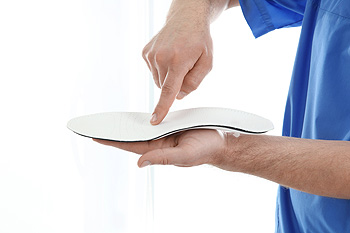
Runners and other people who are active in sports may find that their feet ache at the end of the day. One way to alleviate some of the pain is to invest in orthotics. Typical shoe liners may provide extra cushioning, but if you put miles on your feet each day, as many runners do, it is worth looking into which orthotics would best suit your feet. In cases of avid runners, an insole can be custom-made by a podiatrist to fit your foot. These inserts will likely be made from synthetic, high-performing materials that provide extra support and cushioning. The average lifespan of such orthotics is 400 to 600 miles, which is about the same time as your running shoes generally last. When fitting you with orthotics, your podiatrist will also consider the way you pronate and if you have flat feet, high arches, or any other foot problems. All these factors will help a podiatrist determine the best orthotics for your feet.
If you are having discomfort in your feet and would like to try orthotics, contact the podiatrists from New England Family Foot Care. Our doctors can provide the care you need to keep you pain-free and on your feet.
What Are Orthotics?
Orthotics are inserts you can place into your shoes to help with a variety of foot problems such as flat feet or foot pain. Orthotics provide relief and comfort for minor foot and heel pain but can’t correct serious biomechanical problems in your feet.
Over-the-Counter Inserts
Orthotics come in a wide variety of over-the-counter inserts that are used to treat foot pain, heel pain, and minor problems. For example, arch supports can be inserted into your shoes to help correct overarched or flat feet, while gel insoles are often used because they provide comfort and relief from foot and heel pain by alleviating pressure.
Prescription Orthotics
If over-the-counter inserts don’t work for you or if you have a more severe foot concern, it is possible to have your podiatrist prescribe custom orthotics. These high-quality inserts are designed to treat problems such as abnormal motion, plantar fasciitis, and severe forms of heel pain. They can even be used to help patients suffering from diabetes by treating foot ulcers and painful calluses and are usually molded to your feet individually, which allows them to provide full support and comfort.
If you are experiencing minor to severe foot or heel pain, it’s recommended to speak with your podiatrist about the possibilities of using orthotics. A podiatrist can determine which type of orthotic is right for you and allow you to take the first steps towards being pain-free.
If you have any questions please contact our office located in Milton, MA . We offer the newest diagnostic and treatment technologies for all your foot and ankle needs.
What Are the Risk Factors for Developing Gout
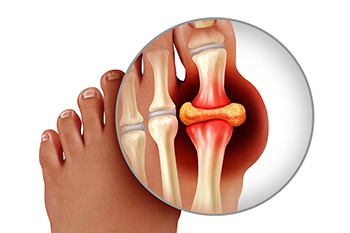
Gout is an arthritic condition that can cause severe pain, redness, heat and swelling in the big toe joint (typically), as well as other joints. This condition is caused by an excessive amount of uric acid in the bloodstream. Uric acid is a byproduct that is produced when the body processes purines, which are chemical compounds found naturally in the body as well as in certain foods. It is believed that consuming large amounts of alcohol, red and organ meat, certain seafood, and high fructose drinks can increase a person’s risk for developing gout. Other risk factors include heredity, being male and/or obese, and having health conditions such as high blood pressure, diabetes, kidney problems, congestive heart failure, and more. Gout flares are sudden onsets of symptoms which can last for days or even weeks, only to disappear for long periods of time as the disease goes into remission for a time. While there is no cure for gout, a podiatrist can help create a treatment and management plan to manage pain and avoid the condition from worsening.
Gout is a painful condition that can be treated. If you are seeking treatment, contact the podiatrists from New England Family Foot Care. Our doctors will treat your foot and ankle needs.
What Is Gout?
Gout is a form of arthritis that is characterized by sudden, severe attacks of pain, redness, and tenderness in the joints. The condition usually affects the joint at the base of the big toe. A gout attack can occur at any random time, such as the middle of the night while you are asleep.
Symptoms
- Intense Joint Pain - Usually around the large joint of your big toe, and it most severe within the first four to twelve hours
- Lingering Discomfort - Joint discomfort may last from a few days to a few weeks
- Inflammation and Redness -Affected joints may become swollen, tender, warm and red
- Limited Range of Motion - May experience a decrease in joint mobility
Risk Factors
- Genetics - If family members have gout, you’re more likely to have it
- Medications - Diuretic medications can raise uric acid levels
- Gender/Age - Gout is more common in men until the age of 60. It is believed that estrogen protects women until that point
- Diet - Eating red meat and shellfish increases your risk
- Alcohol - Having more than two alcoholic drinks per day increases your risk
- Obesity - Obese people are at a higher risk for gout
Prior to visiting your podiatrist to receive treatment for gout, there are a few things you should do beforehand. If you have gout you should write down your symptoms--including when they started and how often you experience them, important medical information you may have, and any questions you may have. Writing down these three things will help your podiatrist in assessing your specific situation so that he or she may provide the best route of treatment for you.
If you have any questions, please feel free to contact our office located in Milton, MA . We offer the newest diagnostic and treatment technologies for all your foot care needs.
When Your Feet Sweat Excessively
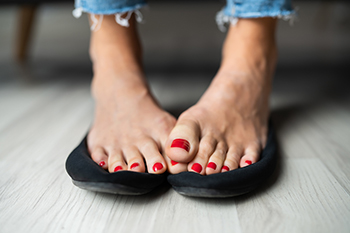 “Hyperhidrosis,” or excessive sweating, can impact the feet. Feet can sweat for a variety of reasons, such as heat, vigorous exercise, pregnancy, shoes that do not fit properly, stress, overuse of feet, side effects of certain medications, or an underlying medical condition like diabetes or thyroid disease. When foot sweat is not cleaned up it can get trapped between toes, which can allow bacteria to grow and enter a cut or ingrown toenail, become infected, and lead to smelly feet (also known as “Bromodosis”). It makes good sense to wash and dry the feet regularly, as well as to wear proper footwear. Additional at home remedies can include foot powders and antiperspirants or medicated insoles. People more apt to develop these types of foot infections are seniors, diabetics, those undergoing hormonal changes (like in pregnancy), and those with compromised immune systems. Such infections must be tended to immediately. If your feet continue to sweat and smell and regular foot hygiene measures do not solve the problem, or if you notice an infection festering, a visit to a podiatrist is suggested for proper diagnosis, a better understanding of the root cause of the problem, and more aggressive treatment.
“Hyperhidrosis,” or excessive sweating, can impact the feet. Feet can sweat for a variety of reasons, such as heat, vigorous exercise, pregnancy, shoes that do not fit properly, stress, overuse of feet, side effects of certain medications, or an underlying medical condition like diabetes or thyroid disease. When foot sweat is not cleaned up it can get trapped between toes, which can allow bacteria to grow and enter a cut or ingrown toenail, become infected, and lead to smelly feet (also known as “Bromodosis”). It makes good sense to wash and dry the feet regularly, as well as to wear proper footwear. Additional at home remedies can include foot powders and antiperspirants or medicated insoles. People more apt to develop these types of foot infections are seniors, diabetics, those undergoing hormonal changes (like in pregnancy), and those with compromised immune systems. Such infections must be tended to immediately. If your feet continue to sweat and smell and regular foot hygiene measures do not solve the problem, or if you notice an infection festering, a visit to a podiatrist is suggested for proper diagnosis, a better understanding of the root cause of the problem, and more aggressive treatment.
If you are suffering from hyperhidrosis contact the podiatrists of New England Family Foot Care. Our doctors can provide the care you need to attend to all of your foot and ankle needs.
Hyperhidrosis of the Feet
Hyperhidrosis is a rare disorder that can cause people to have excessive sweating of their feet. This can usually occur all on its own without rigorous activity involved. People who suffer from hyperhidrosis may also experience sweaty palms.
Although it is said that sweating is a healthy process meant to cool down the body temperature and to maintain a proper internal temperature, hyperhidrosis may prove to be a huge hindrance on a person’s everyday life.
Plantar hyperhidrosis is considered to be the main form of hyperhidrosis. Secondary hyperhidrosis can refer to sweating that occurs in areas other than the feet or hands and armpits. Often this may be a sign of it being related to another medical condition such as menopause, hyperthyroidism and even Parkinson’s disease.
In order to alleviate this condition, it is important to see your doctor so that they may prescribe the necessary medications so that you can begin to live a normal life again. If this is left untreated, it is said that it will persist throughout an individual’s life.
A last resort approach would be surgery, but it is best to speak with your doctor to find out what may be the best treatment for you.
If you have any questions please feel free to contact our office located in Milton, MA . We offer the newest diagnostic and treatment technologies for all your foot and ankle needs.
Athletes and Plantar Fasciitis
 The thick band of tissue that is found on the sole of the foot is known as the plantar fascia. It connects the heel to the toes, and acts as a shock absorber, in addition to providing support to the arch. When the plantar fascia becomes irritated, plantar fasciitis may develop. This can cause pain and discomfort, and the pain may be more severe in the morning after arising. Athletes who develop this condition are often unhappy about it, and it may limit running. It can help to wear supportive footwear, and many athletes gradually increase training. There are specific stretches that can be performed which can help the symptoms of plantar fasciitis. If you would like more information about the causes and treatment of plantar fasciitis, please consult with a podiatrist.
The thick band of tissue that is found on the sole of the foot is known as the plantar fascia. It connects the heel to the toes, and acts as a shock absorber, in addition to providing support to the arch. When the plantar fascia becomes irritated, plantar fasciitis may develop. This can cause pain and discomfort, and the pain may be more severe in the morning after arising. Athletes who develop this condition are often unhappy about it, and it may limit running. It can help to wear supportive footwear, and many athletes gradually increase training. There are specific stretches that can be performed which can help the symptoms of plantar fasciitis. If you would like more information about the causes and treatment of plantar fasciitis, please consult with a podiatrist.
Plantar fasciitis can be very painful and inconvenient. If you are experiencing heel pain or symptoms of plantar fasciitis, contact the podiatrists from New England Family Foot Care. Our doctors can provide the care you need to keep you pain-free and on your feet.
What Is Plantar Fasciitis?
Plantar fasciitis is the inflammation of the thick band of tissue that runs along the bottom of your foot, known as the plantar fascia, and causes mild to severe heel pain.
What Causes Plantar Fasciitis?
- Excessive running
- Non-supportive shoes
- Overpronation
- Repeated stretching and tearing of the plantar fascia
How Can It Be Treated?
- Conservative measures – anti-inflammatories, ice packs, stretching exercises, physical therapy, orthotic devices
- Shockwave therapy – sound waves are sent to the affected area to facilitate healing and are usually used for chronic cases of plantar fasciitis
- Surgery – usually only used as a last resort when all else fails. The plantar fascia can be surgically detached from the heel
While very treatable, plantar fasciitis is definitely not something that should be ignored. Especially in severe cases, speaking to your doctor right away is highly recommended to avoid complications and severe heel pain. Your podiatrist can work with you to provide the appropriate treatment options tailored to your condition.
If you have any questions please feel free to contact our office located in Milton, MA . We offer the newest diagnostic and treatment technologies for all your foot and ankle needs.
Baby’s First Shoes and Walking
 Many parents choose to have their babies wear shoes, despite the fact that research has indicated that shoes are unnecessary to wear until walking begins. At this time, the first shoes often consist of having a flexible and non-slip sole, in addition to fitting correctly. The shoe is ideal when it fits securely on the foot. This can be helpful in preventing stubbed toes, splinters, or broken toenails. There are certain foot conditions that children can develop that require the expertise of a podiatrist. If your child has ingrown toenails, walks on their toes, or doesn’t walk by 15 months, it is suggested that you schedule an appointment with a podiatrist.
Many parents choose to have their babies wear shoes, despite the fact that research has indicated that shoes are unnecessary to wear until walking begins. At this time, the first shoes often consist of having a flexible and non-slip sole, in addition to fitting correctly. The shoe is ideal when it fits securely on the foot. This can be helpful in preventing stubbed toes, splinters, or broken toenails. There are certain foot conditions that children can develop that require the expertise of a podiatrist. If your child has ingrown toenails, walks on their toes, or doesn’t walk by 15 months, it is suggested that you schedule an appointment with a podiatrist.
Making sure that your children maintain good foot health is very important as they grow. If you have any questions, contact the podiatrists of New England Family Foot Care. Our doctors can provide the care you need to keep you pain-free and on your feet.
Keeping Children's Feet Healthy
Having healthy feet during childhood can help prevent medical problems later in life, namely in the back and legs. As children grow, their feet require different types of care. Here are some things to consider...
Although babies do not walk yet, it is still very important to take care of their feet.
Avoid putting tight shoes or socks on his or her feet.
Allow the baby to stretch and kick his or her feet to feel comfortable.
As a toddler, kids are now on the move and begin to develop differently. At this age, toddlers are getting a feel for walking, so don’t be alarmed if your toddler is unsteady or ‘walks funny’.
As your child gets older, it is important to teach them how to take care of their feet.
Show them proper hygiene to prevent infections such as fungus.
Be watchful for any pain or injury.
Have all injuries checked by a doctor as soon as possible.
Comfortable, protective shoes should always be worn, especially at play.
If you have any questions please feel free to contact our office located in Milton, MA . We offer the newest diagnostic and treatment technologies for all your foot and ankle needs.
Ways to Lower the Risk of a Running Injury
Runners understand the joy the sport brings, however, they are also aware of the possible pain that can come with the activity as well. About 70 percent of all runners injure themselves each year. They may run too fast, too far, or too soon after a previous injury. Luckily, a number of simple guidelines can keep runners on the move. If you are new to running, it’s wise to take it in phases that include walk-run activity. Try not to increase your activity more than 10 percent a week, and try to avoid running more than 45 miles per week, because after that distance, injury is more likely to occur. It’s important to listen to your feet and avoid running through pain. Give your feet and legs a chance to heal before renewing activity. Find running shoes that fit your feet well and cushion your heels, and get new ones after 500 miles. Finally, there are a number of stretching and strengthening exercises you can do to help avoid injuries. If you run consistently, it’s a good idea to plan regular visits with a podiatrist, who can examine your feet, identify any problems, and make custom orthotics as needed.
Exercising your feet regularly with the proper foot wear is a great way to prevent injuries. If you have any concerns about your feet, contact the podiatrists of New England Family Foot Care. Our doctors will treat your foot and ankle needs.
How to Prevent Running Injuries
Many common running injuries are caused by overuse and overtraining. When the back of the kneecap starts wearing out and starts causing pain in your knee, this is commonly referred to as runner’s knee. Runner’s knee is a decrease in strength in your quadriceps and can occur if you’re not wearing properly fitted or supporting shoes. To prevent runner’s knee, focusing on hip strengthening is a good idea, as well as strengthening your quads to keep the kneecaps aligned.
What Are Some Causes of Running Injuries?
- One cause of a common running injury is called iliotibial band syndrome.
- Plantar fasciitis is also another common injury.
- Stress fractures can occur from overtraining, lack of calcium, or even your running style.
Best Ways to Prevent Running Injuries
- Wear footwear that fits properly and suits your running needs.
- Running shoes are the only protective gear that runners have to safeguard them from injury.
- Make a training schedule. Adding strengthening exercises as well as regular stretching can help keep you strong and limber and can lessen the possibility of injuries.
- Stretching keeps muscles limber; this will help you gain better flexibility.
If you have any questions please feel free to contact our office located in Milton, MA . We offer the newest diagnostic and treatment technologies for all your foot and ankle needs.
How Bunions Form
 Bunions are a common foot deformity known as a small, bony lump on the side of the big toe. This bony protrusion usually forms due to the big toe bending towards the smaller toes when it should be straight, thus pushing the bones out of alignment. Bunions gradually form over time and typically get worse without treatment. The angle of the bunion gets sharper, and the bump can grow larger. In severe cases, surgery may be necessary. Bunions may be the result of an inherited mechanical structure, or they may form from wearing shoes that are too tight. Common symptoms of a bunion include pain in the affected area, inflammation, a burning sensation, and possible numbness. It is suggested that larger shoes, or shoes with a wide toe box be worn when you are afflicted with a bunion. Patients who are struggling with this ailment should consult with a podiatrist as soon as possible to determine the best course of treatment.
Bunions are a common foot deformity known as a small, bony lump on the side of the big toe. This bony protrusion usually forms due to the big toe bending towards the smaller toes when it should be straight, thus pushing the bones out of alignment. Bunions gradually form over time and typically get worse without treatment. The angle of the bunion gets sharper, and the bump can grow larger. In severe cases, surgery may be necessary. Bunions may be the result of an inherited mechanical structure, or they may form from wearing shoes that are too tight. Common symptoms of a bunion include pain in the affected area, inflammation, a burning sensation, and possible numbness. It is suggested that larger shoes, or shoes with a wide toe box be worn when you are afflicted with a bunion. Patients who are struggling with this ailment should consult with a podiatrist as soon as possible to determine the best course of treatment.
If you are suffering from bunions, contact the podiatrists of New England Family Foot Care. Our doctors can provide the care you need to keep you pain-free and on your feet.
What Is a Bunion?
A bunion is formed of swollen tissue or an enlargement of boney growth, usually located at the base joint of the toe that connects to the foot. The swelling occurs due to the bones in the big toe shifting inward, which impacts the other toes of the foot. This causes the area around the base of the big toe to become inflamed and painful.
Why Do Bunions Form?
Genetics – Susceptibility to bunions are often hereditary
Stress on the feet – Poorly fitted and uncomfortable footwear that places stress on feet, such as heels, can worsen existing bunions
How Are Bunions Diagnosed?
Doctors often perform two tests – blood tests and x-rays – when trying to diagnose bunions, especially in the early stages of development. Blood tests help determine if the foot pain is being caused by something else, such as arthritis, while x-rays provide a clear picture of your bone structure to your doctor.
How Are Bunions Treated?
- Refrain from wearing heels or similar shoes that cause discomfort
- Select wider shoes that can provide more comfort and reduce pain
- Anti-inflammatory and pain management drugs
- Orthotics or foot inserts
- Surgery
If you have any questions, please feel free to contact our office located in Milton, MA . We offer the newest diagnostic and treatment technologies for all your foot care needs.
Bunions
A bunion is an enlargement of the base joint of the toe that connects to the foot, often formed from a bony growth or a patch of swollen tissues. It is caused by the inward shifting of the bones in the big toe, toward the other toes of the foot. This shift can cause a serious amount of pain and discomfort. The area around the big toe can become inflamed, red, and painful.
Bunions are most commonly formed in people who are already genetically predisposed to them or other kinds of bone displacements. Existing bunions can be worsened by wearing improperly fitting shoes. Trying to cram your feet into high heels or running or walking in a way that causes too much stress on the feet can exacerbate bunion development. High heels not only push the big toe inward, but shift one's body weight and center of gravity towards the edge of the feet and toes, expediting bone displacement.
A podiatrist knowledgeable in foot structure and biomechanics will be able to quickly diagnose bunions. Bunions must be distinguished from gout or arthritic conditions, so blood tests may be necessary. The podiatrist may order a radiological exam to provide an image of the bone structure. If the x-ray demonstrates an enlargement of the joint near the base of the toe and a shifting toward the smaller toes, this is indicative of a bunion.
Wearing wider shoes can reduce pressure on the bunion and minimize pain, and high heeled shoes should be eliminated for a period of time. This may be enough to eliminate the pain associated with bunions; however, if pain persists, anti-inflammatory drugs may be prescribed. Severe pain may require an injection of steroids near the bunion. Orthotics for shoes may be prescribed which, by altering the pressure on the foot, can be helpful in reducing pain. These do not correct the problem; but by eliminating the pain, they can provide relief.
For cases that do not respond to these methods of treatment, surgery can be done to reposition the toe. A surgeon may do this by taking out a section of bone or by rearranging the ligaments and tendons in the toe to help keep it properly aligned. It may be necessary even after surgery to wear more comfortable shoes that avoid placing pressure on the toe, as the big toe may move back to its former orientation toward the smaller toes.









